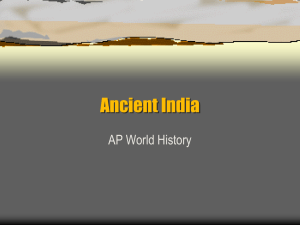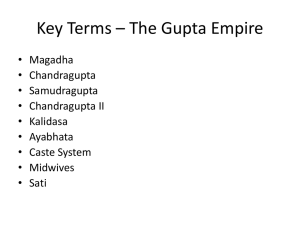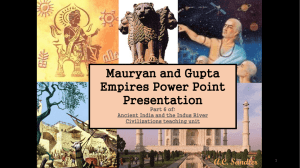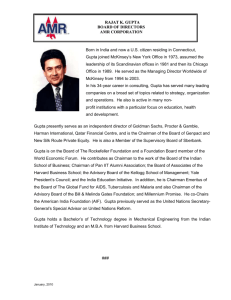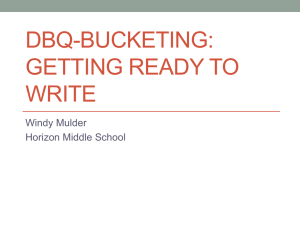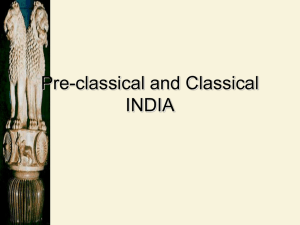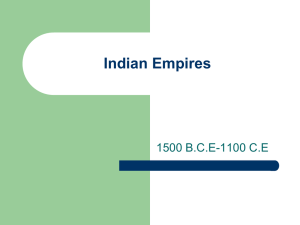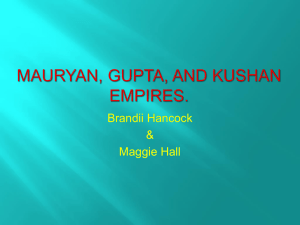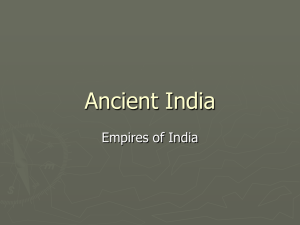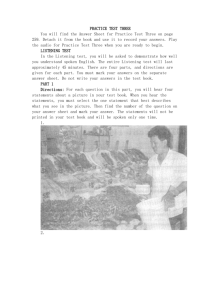All About India Chart – ANSWERS
advertisement
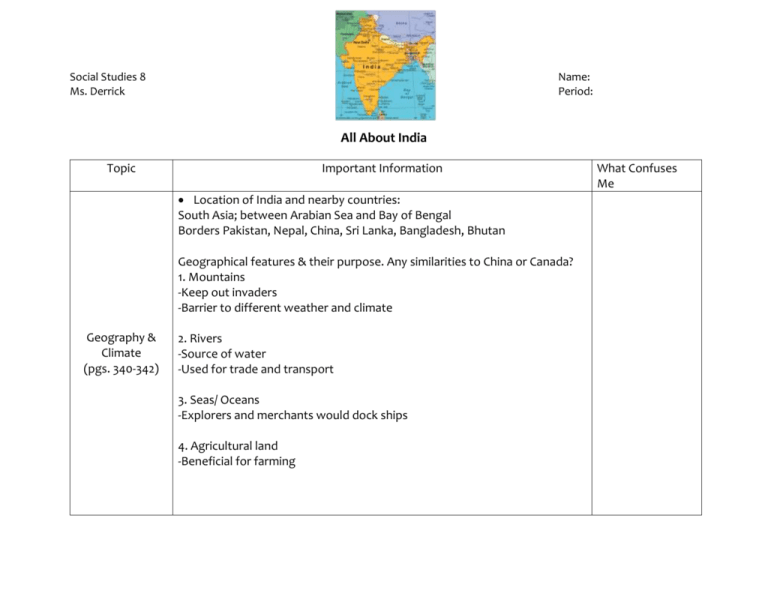
Social Studies 8 Ms. Derrick Name: Period: All About India Topic Important Information Location of India and nearby countries: South Asia; between Arabian Sea and Bay of Bengal Borders Pakistan, Nepal, China, Sri Lanka, Bangladesh, Bhutan Geographical features & their purpose. Any similarities to China or Canada? 1. Mountains -Keep out invaders -Barrier to different weather and climate Geography & Climate (pgs. 340-342) 2. Rivers -Source of water -Used for trade and transport 3. Seas/ Oceans -Explorers and merchants would dock ships 4. Agricultural land -Beneficial for farming What Confuses Me Problems that geography & nature cause in India: -Flooding due to heavy monsoons -Heat can damage crops -Bodies of water can bring invaders When did the Indus Civilization take place? 2500 BCE to 1500 BCE What were some of the accomplishments of the Indus Civilization? -Ancient cities included streets, private homes, public baths, shops -Cotton textiles -Contact with other civilizations and engaged in trade -Used fertile soil for agriculture Indus Civilization and Aryan List some facts about the Aryans: Invaders -War-like and nomadic chariots, archery (pgs.343-344) -Believed in many gods and made offerings -Developed the caste system to organize society around -Indo-European language called Sanskrit (later Hindi and Punjabi) What is a caste? Can you name some castes? Do you think there are still castes in India? -A social group limited to persons of the same rank -Brahman (priest), Kshatriya (warrior), Vaishya (commoner), Sudra (slave) -Yes, there are still people who believe in the caste system, but it is not as prominent as it once was What Confuses Me The Northern and Southern Empires (pgs. 345-346) Was southern India often invaded? Why or why not? -No, because it was protected by the Vindhya Range and the rocky Deccan Plateau and the Eastern and Western Ghats What Confuses Me Which European invaded northern India in 330 BCE? -Alexander the Great (claimed part of Pakistan but did not hold power long) The Northern and Southern Empires (pgs. 345-346) Who was Ashoka and what were some of his accomplishments? -Grandson of Chandragupta -Brought together almost all of India -Many people killed in battles led by him, but then converted to Buddhism and believed killing was wrong -Improved villages by creating wells and planting trees, offering medical aid -Believed in religious tolerance -Eventually became monk Who created the Gupta Empire and what nickname does the empire have? What Confuses Me -Chandragupta; the “Golden Age” The Gupta Intro & Economy (pgs. 347-348) Describe 3 types of employment during the Gupta Empire: 1. Farmers -Lived in villages -Taxed for income -Money went to royal treasury and supported temples and priests - The Gupta Intro & Economy (pgs. 347-348) 2. Artisans -Craftsperson -Belonged to specialized guilds called shreni -Produced cloth, pottery, metalware, oils -Shared profits collectively -Membership usually hereditary 3. Traders & explorers -Regular trade with China and the Romans What is a caste (hint: pg. 344) and how did they affect Gupta society? -3000 castes developed -People forbidden to marry outside of caste; forbidden to socialize with others -Occupations depended on caste The Gupta Intro & Social Life & Intellectual Life (pg. 347 & 349) What Confuses Me What was the status of women during the Gupta Empire? Was it better or worse than in Medieval Europe? Explain -Declined during this time -Could sometimes own property -Higher caste women confined to home -Some women performed sati (throw themselves on fire) b/c widows shunned -Sons > daughters (could take care of parents more) What Confuses Me What were some of the “intellectual” aspects of life that flourished under Gupta rule? -Monasteries for religion and philosophy -Mathematics (numbering system and decimal) and physics -Languages -Art (Buddhist and Hindu gods), esp. in nature The Gupta Intro & Social Life & Intellectual Life (pg. 347 & 349) The Muslim Conquest (pgs. 358-362) What Confuses Me The Gupta Empire is often called the “Golden Age.” Do you think it is similar to the “Golden Age” in Ancient China, the Tang Dynasty? Why or why not? What is a sultanate? What religion did these sultans believe in, and what country did they originally come from? -Rule by a sultan (Muslim ruler) -Believed in Islam and originally from Turkey In 1206, which city was created? What is its importance in the present day? -Delhi was created -Currently the capital of India (9.9 million people) What Confuses Me How did the sultans rule and who were some of their enemies? Were they successful in defeating them? -Diplomacy and warfare to maintain power -Used murder and intrigue against rivals -Enemies included the Tamils in the south -Lost in many naval battles against them The Muslim Conquest (pgs. 358-362) Who defeated the Delhi Sultanate? Where were they from and what are two facts about them? -The Mughals (Mongols) -From central Asia -Built the Taj Mahal -Developed a rich culture What were some of the accomplishments of Akbar? -Reformed the empire -Believed in religious tolerance -Appointed qualified Hindus to work in his government and gave them fixed salaries -Taxes were more fair; developed a better currency; protected transportation routes List two facts about one of these individuals: Jahangir, Shah Jahan, Aurangzeb -Jahangir: Persian arts to India, heard petitions from subjects, literature -Shah Jahan: Taxed people heavily, spent money on decoration & buildings -Aurangzeb: Deposed Shah Jahan, suppressed Hinduism What Confuses Me
